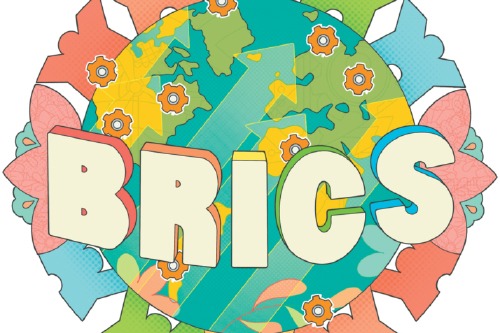Accelerated transition


The BRICS countries need to catalyze more streams of funding to expedite the decarbonization of high-emission industries
In the run-up to the BRICS 2022 Summit, the second BRICS finance ministers and central bank governors meeting was held virtually on June 6, with "transition finance" being one of the centerpieces.
The BRICS countries represent nearly 25 percent of the world's GDP and are going through rapid industrialization coupled with above-world-average carbon emission intensities. Guided by the common but differentiated responsibility principle, the five developing countries still face immense challenges to decarbonize hard-to-abate industries such as shipping, aviation, steel, cement and chemicals.
From the financial perspective, with the climate crisis growing, an increasing number of financiers and investors are reluctant to fund these carbon-intensive sectors due to the fear of changing policies and stranded asset risks. Meanwhile, the incurred financial stability concerns and high-emitting sectors' transition needs are left unaddressed.
As a solution, transition finance aims at entity- and activity-level decarbonization efforts in high-emitting sectors that are largely neglected by the green finance market.
Decarbonizing the economy is one of the main challenges before the BRICS countries. A matching transition finance system has become vital to help hard-to-abate sectors transition toward net-zero emissions while preventing "transition wash". A well-structured system consists of six pillars-a transition taxonomy, disclosure frameworks, transition-related risk management, tailored financial instruments, policy incentives and a just transition mechanism.
Although none of the BRICS countries have introduced a national transition taxonomy or transition disclosure rules, some are geared in that direction. For example, at the local level in China, Huzhou in Zhejiang province has published its local transition finance taxonomy. Russia and South Africa also have plans for national transition taxonomies in the pipeline. As for financial institutions, the Bank of China and China Construction Bank recently released their transition bond frameworks.
To ensure the macroeconomy and the financial system can stay resilient to climate change, great importance should be attached to adequate assessment and proper management of the transition risks.
The central banks of the BRICS countries have all proposed or implemented relevant macroprudential policies. For example, the central bank of Brazil requires banks to incorporate climate risks into their stress tests starting from July, 2022. The central banks of India, China and South Africa also launched supervisory climate risk stress tests to assess how prepared banks are in the face of climate-related transition risks.
It requires a variety of financial instruments to finance the transition pathways of high-emitting sectors. All BRICS countries have developed at least one type of financial instrument for such a transition, for instance, transition bonds or sustainability-linked bonds (loans). Unlike green bonds and loans, which are earmarked to raise money for green projects, transition finance instruments provide funds to help "brown" sectors decarbonize.
For example, in 2021, the Indian steel producer JSW Steel issued $500 million in sustainability-linked bonds, with the sustainability performance target being to reduce CO2 emissions by 23 percent by 2030 from its 2020 levels.
Effective policy incentives are essential for an orderly low-carbon transition. One of the tools is monetary policy, such as the discounted loans provided by the central bank of China for banks via a carbon-reduction supporting scheme; the others include carbon pricing tools such as a carbon tax and the emission trading system, both of which help internalize the external costs of greenhouse gas emissions. China is the only BRICS country that has established a nationwide emission trading system, while South Africa is the only BRICS country that has imposed a carbon tax.
As developing countries, the BRICS nations face the challenge of balancing between decarbonization and just transition. A just transition ensures that the transitions away from fossil fuels are not at the cost of workers' livelihoods. South Africa, as a coal-reliant country, is pivoting toward a just transition with international aid. The country has been negotiating a $8.5 billion climate finance package in a just transition partnership with France, Germany, the United Kingdom, the United States and the European Union. This partnership sets a precedent for international collaboration on just transition efforts.
Going forward, the BRICS countries can improve the development of transition finance in the following areas-establishing transition finance taxonomies and transition disclosure regulation, innovating various transition finance instruments, and promoting international cooperation on just transition.
A well-developed taxonomy is indispensable to channeling funds toward transition activities. The BRICS countries should establish transition taxonomies that are not only accustomed to their country-specific needs, but also commendable against international best practices, for example, the transition taxonomies experimented by jurisdictions such as the European Union, Japan and voluntary guidelines provided by leading international organizations such as the International Capital Market Association and Climate Bond Initiative. The G20 Sustainable Finance Working Group has initiated the drafting of a transition finance framework.
The regulatory bodies should strengthen disclosure requirements, including on transition strategies and pathways, technologies, different scopes of greenhouse emissions, and usage of proceeds from transition financing.
In terms of financial instruments, at the current stage, the majority are transition bonds and sustainability-linked bonds. The BRICS countries would benefit from a full-suite of products and diverse sources of funding, for example, venture capital and private equity on a mission to support their transitions.
To guarantee a just transition, the BRICS countries can leverage bilateral and multilateral grants, loans and technical assistance to catalyze more streams of funding. Developing countries would find a just transition less challenging to achieve with the help from the multilateral development banks, international organizations and partnering countries.
Although the BRICS countries' transition finance is still in a nascent stage, it is hoped that, with its accelerating pace, the five countries will continue to show leadership in the low-carbon transition and keep the Paris Agreement alive.
Tang Yingzhi is deputy director of the Green Belt and Road Initiative Center at the International Institute of Green Finance. Chen Han is a researcher at the International Institute of Green Finance.
Contact the editor at editor@chinawatch.cn


































